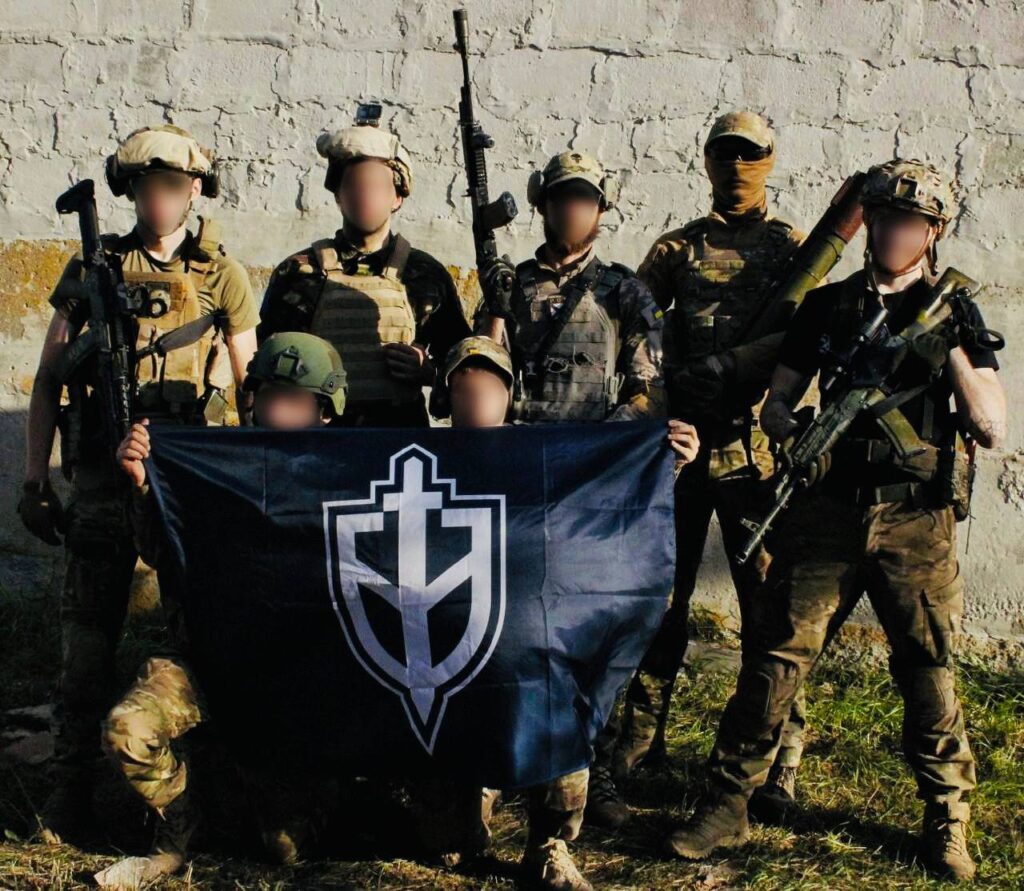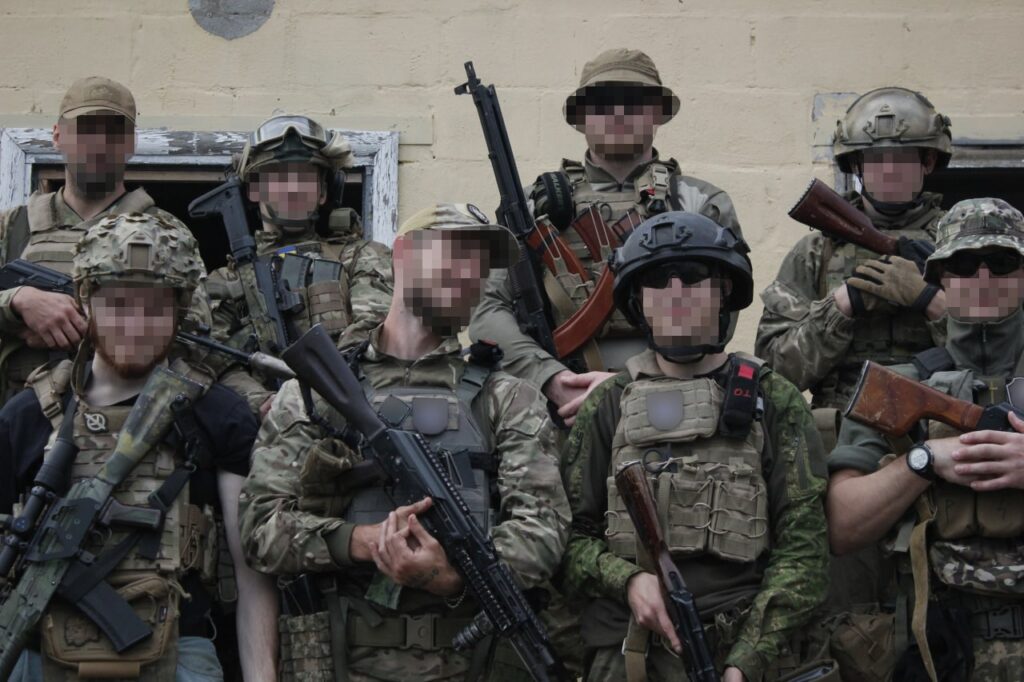A new unit consisting of Russian volunteers has appeared on the Ukrainian side. It calls itself the Russian Volunteer Corps. Antifascist Europe has concluded that the group is made up of neo-Nazis from Russia, who were organized by the well-known far-right entrepreneur Denis “WhiteRex” Kapustin.

A short overview of the Russian Volunteer Corps (RDK)
The Russian Volunteer Corps (RDK) is a new volunteer unit made up of far-right militants from Russia fighting on the Ukrainian side. Information about the group first appeared in August on a Telegram channel, which belongs to a well-known Russian neo-Nazi entrepreneur named Denis “WhiteRex” Kapustin (Nikitin). Denis Kapustin himself appears in the video with a gun in his hands. The RDK doesn’t currently have a separate entity status. The group is made up of cadres from various armed formations. The number of people involved in the unit is not known; only a few people have emerged in the public arena. The RDK uses symbols of the Russian Liberation Army (or ROA, who collaborated with the Nazis during World War II), which is typical for Russian neo-Nazis, and found itself at the centre of a political scandal surrounding the Russian opposition in Ukraine.
Preface: How Russian Nazis ended up in Ukraine
Russian Nazis have been using Ukraine as a refuge from Russian law enforcement agencies since the mid-2000s. One of the most notorious figures was Alexander Parinov, nicknamed the “Romanian” or “Vadik”, from the neo-Nazi terrorist organization BORN, who fled to Ukraine in 2009 after killing the antifascist activist Aleksandr Ryukhin. He has never been punished for his crimes and is now allegedly fighting in the ranks of the Azov Regiment. An associate of Parinov, Aleksey Korshunov, nicknamed “Korshun” and wanted in Russia for a number of murders, accidentally blew himself up with his own grenade while jogging in a stadium in Zaporizhzhia in 2011.
The mass migration of Russian neo-Nazis began in 2014 after the Euromaidan uprising, which they saw as a “nationalist revolution”, and the ensuing military activity in south-eastern Ukraine sparked a high degree of excitement among the Russian far right. The far right in Russia split into two opposing camps on the issue of Ukraine and began shooting at each other in the fields of the Donbas. On 11 October 2015, Russian neo-Nazis established the Russian Center in Ukraine, which brought together some 30 opponents of Putin’s regime. Among them were well-known neo-Nazis such as Denis Vikhorev (Tyukin), Ivan “Fritz” Micheev, Alexey Levkin from WotanJugen, Roman “Zukhel” Zheleznov from Misanthropic Division, Ilya Bogdanov, Andrey Kuznetsov, Alexander Neunets, and Mikhail Oreshnikov (check the AE database for detailed profiles). Delegates to the congress noted that the key objective was to “form an organizational component of Russian revolutionary nationalism in Ukraine’’. Their main practical objective was legalization and obtaining Ukrainian passports.
After the infamous expulsion of Roman Zheleznov as a result of internal conflict, the activities of the Russian Center were terminated. The Russian Center’s website remains accessible but has not been updated for a long time. The Telegram channel is actively maintained, most likely by Denis Vikhorev.
How the Russian Volunteer Corps was created

In late August 2022, announcements were circulated in the media about the creation of a new unit in Ukraine, the Russian Volunteer Corps (RDK). According to DW, the RDK includes Russians from the Azov regiment of the Ukrainian National Guard and the Right Sector Ukrainian Volunteer Corps. Some fighters are now individually enrolled in the territorial defence forces, or rather in the Volunteer Defence Forces of territorial communities. Some fighters have not yet received any official status at all. The leader of the unit told Russian right-wing journalist Roman Popkov that “the issue of the legalization of the RDK is being resolved, and two Ukrainian security agencies have even started competing for the right to integrate the Corps into their structures”.
Before the Corps was founded, the most publicized Russian unit within the Ukrainian Armed Forces (UAF) was the Freedom Legion. It became known in the spring of 2022 when several men wearing masks and Russian camouflage uniforms without insignia gave a press conference in Kyiv. They said they were members of the Russian army, had been captured, and had now decided to defect to a country that had been subjected to Kremlin aggression. Unlike the Legion, the leadership of the Corps does not rely on former Russian soldiers who ended up in the Legion after surrendering but on Russian right-wing migrants living in Ukraine. Furthermore, the Corps stressed that they do not interact with the Legion.
RDK members told Popkov that at the beginning of the war, Corps members fought alone or in small groups in various units of the Ukrainian Territorial Defence Forces. In February and March, they got into trouble repeatedly because of their Russian passports when trying to integrate themselves into the Ukrainian resistance. They were detained at checkpoints, and one fighter was handcuffed for several hours in police custody.
“At some point, the realization came: the Belarusians, Georgians, and Chechens have their own national formations in Ukraine, but we Russians don’t! So we decided to create such a unit. The advantage of the Corps is that it grows out of a friendly group of like-minded people, so decisions are made quickly, and we act in harmony,” said Denis, one of the commanders of the formation, in a conversation with Roman Popkov. According to him, the Corps fighters “can rather be classified as belonging to the right-conservative political spectrum”. This Denis likely refers to Denis WhiteRex—whose involvement will be discussed in more detail below.
On 25 July, the RDK channel on Telegram was registered. On 11 August, it published an official statement: “We Russian volunteers living in Ukraine have decided to take up arms and create a military formation—the Russian Volunteer Corps—so that together with our Ukrainian comrades-in-arms, we can defend their homeland, which shelters us, and then continue the fight against Putin’s criminal regime and its henchmen.”
The Corps outlined its primary goal as follows: “The ultimate programme is to overthrow the Putin regime and establish a new, truly faithful and decent power in Russia that will not engage in acts of aggression and wage local wars but will peacefully co-exist with the rest of the world, focusing more on domestic rather than foreign policy”.
How Ilya Ponomarev and the RDK tried to become friends

On 31 August, Ukrainian media reported that the Russian Volunteer Corps, the Freedom Legion, and the National Republican Army had signed a declaration of cooperation in Irpin, on the outskirts of Kyiv. These organizations claim that they are engaged in armed resistance against the regime of Vladimir Putin. This was reported by former Russian State Duma member and businessman Ilya Ponomarev, who intends to lead Russia’s armed opposition in Ukraine.
The National Republican Army (NRA) is the unidentified organization that claimed responsibility for the murder of Darya Dugina on 20 August, daughter of the Russian far-right philosopher Aleksandr Dugin. Ilya Ponomarev published an NRA statement on his YouTube channel. All information about the National Republican Army has thus far come from Ponomarev.
Ponomarev also published the text of the Irpin Declaration. The signatories of the document state that they have a common “objective to liberate Russia from Putin’s tyranny, to stop the terror of the Kremlin security forces against their own citizens and those of other countries, and to end the war of aggression against Ukraine as soon as possible”.
According to Ponomarev, the organizations agreed to coordinate their actions “on armed resistance to Putin’s fascism”, to conduct a common information policy, and decided that while retaining the symbols of their units, they would “adopt a joint white-blue-white flag as a symbol of their joint struggle”. The Russian Volunteer Corps, the Freedom Legion, and the National Republican Army have also agreed to establish a shared political headquarters, which aims to represent their interests to the state authorities of different countries and organize a common information policy. The headquarters will be run by Ponomarev.
However, on the same day, an official denial appeared on the Corps’s Telegram channel, stating that representatives of the RDK had not signed any form of the so-called “Declaration of the Russian Armed Opposition” and did not recognize the white-blue-white flag as their symbol. Ponomarev never explained what really happened. In August, Ponomarev actively reposted the RDK channel and even published an interview with one of the masked fighters, but after the conflict, the reposts stopped.
Importantly, Ponomarev’s assistant in Ukraine became a well-known Russian neo-Nazi, Alexei Baranovsky, who was a lawyer and assistant to nationalist MPs in the State Duma. Baranovsky became known as the сoordinator of the Russian Verdict Information, which offered legal help to arrested neo-Nazis. The Russian Center claimed that Baranovsky and Ponomarev were part of an FSB plan to destroy the Russian nationalist movement.
Which symbols does the RDK use?

The banner of the Russian Volunteer Corps is a stylized “dagger”, designed by a Nazi collaborator and Russian Liberation Army (ROA) officer Viktor Larionov—a figure whose ideas, principles, and beliefs provide a prominent reference point for the Russian Volunteer Corps, allowing them to claim a certain historical and political continuity.
“One of the most important principles of our unit is the principle of irreconcilability—the rejection of any form of cooperation with the successor of the Soviet regime—Putin’s government and its representatives and lackeys abroad. It is important to remember that it is Putin and his henchmen who destroy Russians as an ethnos, replacing them with the artificial notion of a “political nation”, and who have now decided to destroy the Ukrainian ethnos as well, completely filled with their own fear of freedom and truth”, said the RDK in an official statement. The words “destroy Russians as an ethnos” can be linked to a Telegram channel run by Denis WhiteRex.
It should be noted that the Russian Center claims to have been the first to use Larionov’s dagger as a political symbol. In August, the Russian Center channel reposted an announcement of the founding of the RDK but later deleted the post as a result of a conflict with the “communist” Ilya Ponomarev, who founded the Youth Left Front in Russia.

Fighters in the Russian Volunteer Corps also widely use ROA insignia (the fighter on the right is wearing it on his chest). The ROA was a collaborationist formation, primarily composed of Russians, which fought under German command during World War II.
How the RDK became connected with Denis WhiteRex

Until August, there was no knowledge of the Russian Volunteer Corps. On 11 August 2022, a prominent Russian neo-Nazi entrepreneur, Denis “WhiteRex” Kapustin (Nikitin), published a video about a “corps of Russian volunteers which fights in one of the hottest sections of the front”. The video showed the RDK’s symbol and also captured the fighters in the background of the symbol, as well as Nikitin himself wearing body armour with a red marking.

Nikitin has since reposted at least five times content from the RDK on his channel without explicitly stating anywhere that he is a member of the Corps. The RDK channel has published photos in which Nikitin is clearly visible, even when his face is pixellated. In this photo, he is third from the left, wearing body armour with a red mark and his company’s trademark WhiteRex symbol on his chest. On 8 September, he posted a photo of himself, with his face clearly recognizable, wearing the same body armour with a red mark and a WhiteRex symbol on his chest.

Anti-Fascist Europe experts studied the accounts of Denis Kapustin and the RDK and concluded that Kapustin was directly involved in organizing the unit. Kapustin’s political ambitions—as well as his significant organizational skills and links to the far-right underground across Europe—make him the ideal leader. As early as the beginning of March, Kapustin was trying to organize the transport of neo-Nazis from around Europe to Ukraine. You can read more about this in our May report, “How Foreign Far-Right Volunteers Are Arriving to Fight in Ukraine”.

Other neo-Nazi symbols

On 18 August, a photo of a fighter nicknamed “Slavyan” was posted on the channel. The photo clearly shows neo-Nazi tattoos—three swastikas on his left arm, a “sig” rune (ᛋ, meaning victory) on his left hand and a “tiwaz” rune (ᛏ) on his chest. Slavyan became one of the public faces of the RDK and has appeared at least three times on its channel.

On 16 September 2022, the RDK published a post in memory of Russia’s most notorious neo-Nazi skinhead, Maxim “Tesak” Martsinkevich, who died in prison in 2020. The RDK also published a video showing a fighter loading an RPG rocket with the inscription “For Tesak!”.
Conclusion
The Russian Volunteer Corps is the first attempt by Russian neo-Nazis to unite in a political-military alliance abroad since the failed Russian Center. In this sense, they make a historical connection with the White Movement, which they have chosen as their ideological predecessors. Although the size of the RDK is unknown, according to Alexey Levkin, there are now about 500 Russians fighting on the side of Ukraine with weapons in their hands, 50 of them far-right militants. Although this is a relatively small number, these people have already managed to attract the attention and support of far-right audiences from all over the world. Real combat experience, veteran status, and experience of political organization during the war will enable the neo-Nazis to consolidate their efforts and make demands in relation to the post-war order that will be established in Russia and Ukraine. The association with Ponomarеv, who claims to be the main Russian opposition politician, will allow the RDK to gain some power. However, their unclear status within the UAF and the split after the Irpin declaration means that the Ukrainian ruling class has not been able to fully determine their position and role in the war.







